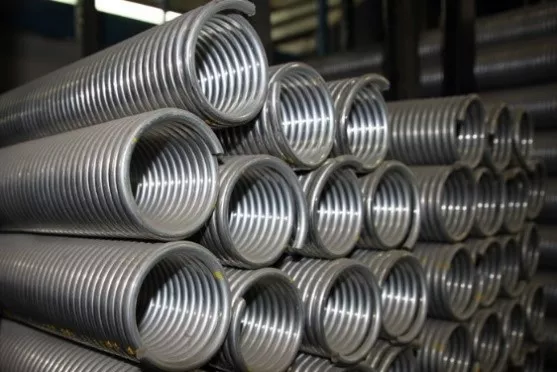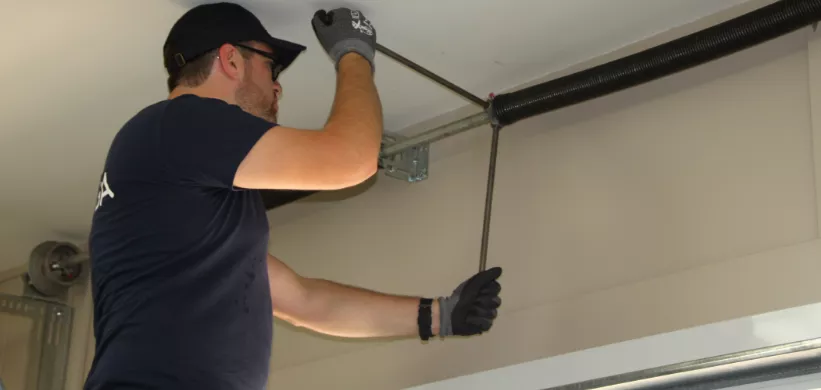Have you ever sat and wondered what a torsion spring is? Or maybe how it works in your garage door system? This might not be something you think about until a spring breaks or you are in need of a new garage door system. The spring system in your garage counterbalances the weight of your garage door. This is done so you can easily open the door manually or use an electric door opener to open it for you.
One of the most important parts of the garage door is the spring system, which is why it’s so crucial that you understand how it works and what it does.

Fundamentals to get you started
Before talking about anything else, you should be aware that sectional overhead garage doors can come with two two types of springs: the extension type and the torsion type. If you have springs installed over the head of the door, that’s a torsion spring. If the springs are installed above horizontal tracks, that is an extension spring.
Wondering which type of spring is the most common to see? It is going to be the torsion spring and there are several reasons for that. These springs are safer to use. They are quieter. They also tend to work the best.
- The reason torsion springs are quieter is because they are located on the wall near the door instead of over the tracks. This leads to less noise transmission when someone opens or closes the door.
- If you are concerned about accidents, the torsion spring is the way to go. The spring is inside of a shaft so that even if it breaks, it will not fly out and cause damage. Extension springs do not always have safety cables and when breaking can hit a wall or car and lead to problems.
- When you use a torsion spring, the weight of the door and all its energy transfers to the anchor plate at the center of the door. This ensures the door is going to open in a balanced way and does so smoothly. With dual extension springs, if anything is improperly adjusted, it can lead to the feeling of vibrations or shaking when you open up the garage door.
The way torsion springs work
Torsion springs are in all sorts of products and have a huge number of uses. These springs are shaped like a coil and they work through the use of twisting or torsion. Mechanical energy is stored to make sure the door can be easily lifted when using an electric door opener or through manual means. The most modern new systems are a far cry from the old counterweight systems that were popular back in the sixties.
Other components that work with the spring system
When learning how a system with a torsion spring works, you will quickly realize that it doesn’t do the job all on its own. The spring is placed inside of a shaft and the shaft is held tightly through the use of a mounted central plate. In addition to that, the shaft connects to a drum with grooves which has a lifting cable wound around it. The cable connects to the bottom of the door with the use of a screwed in the bracket on the door. As such, all the parts work together and are connected together: bottom bracket + lifting cable + drum + shaft + spring. At times when the door is closed, the energy of the system is held in the spring. When the door is open, the system relaxes instead.
Are you now wondering how much an average garage door weighs? It varies, but the following reference points will help:
-
For a 1 ¾"‑thick steel door which has been insulated with polyurethane foam: the weight is going to be about 2 lb. per square foot (but if windows are present, those are going to weigh about 2 ½ to 3 lb. each), which means:
- 9 x 7 ft. = around 150 to 160 lb. (68 to 73 kg)
- 16 x 7 ft. = around 280 to 295 lb. (127 to 135 kg)
-
For a 2"‑thick steel door door which is non-insulated: the weight is going to be about 1 ½ lb. per square foot, meaning:
- 9 x 7 ft. = around 125 to 130 lb. (57 to 59 kg)
- 16 x 7 ft. = around 280 to 295 lb. (102 to 107 kg)
Extra questions about torsion springs answered
-
Are single door springs, when viewing them from inside the garage, always installed on the left or right of the door?
Some torsion springs are manufactured to go on the left of the door while others are made to go on the right. Both of them work just the same regardless of that position.
-
Is one spring enough or are two better?
If you have a 9 x 7 ft. single door, it will likely have only a single spring. However, 16 x 7 ft. double doors are going to have two torsion springs.
-
How long is a spring’s average lifespan?
Most of the springs that manufacturers create have a rating of 10,000 cycles. One cycle means that the garage door is opened and closed once. That means that someone who opens the door two or three times a day can expect the springs to last for approximately seven years. Keep in mind that torsion springs do lose some strength as time goes on. Those who need a spring with a longer life can look at those rated for 20,000 to 25,000 cycle.
-
Is a torsion spring galvanized?
In the majority of cases, torsion springs are galvanized with about 35 or 40% zinc to prevent rusting. Those who have very humid garages may want to consider a torsion spring that is fully galvanized for the best results.
-
Are there ways to make a spring last longer?
If you use your springs normally and handle regular lubricating of any of the metal parts that contact each other in any way, this is an excellent way to prevent early corrosion. That means lubricating the metal rollers, hinges, and the spring system as a whole. Another perk of lubricating the parts is that it removes the noise that occurs when the coils of springs rub together. Make sure you only use a petroleum‑based lubricant.
-
Is there a way to find out if my springs are effective or not?
The best way to determine the effectiveness of the springs is by opening the door manually. Make sure you deactivate the garage door opener and then attempt to lift the door. Springs that are in good shape should make the door feel as if it weighs only about 8 to 10 lb. (3 to 5 kg.) and lifting it without straining should be simple with one hand.
-
Are torsion springs always located in the front of the garage?
Assuming there is less than 12” (30 cm.) of headroom over the door, that isn’t the case. Instead, the springs will be behind the door in the rear. Double horizontal tracks are what will be used if this is the case.
Repairing a broken spring is dangerous
Even if you have heard it before, you need to be aware that you should never try to change out a broken torsion spring on your own. This is a very dangerous situation. If you are located in or near Ellington or Hartford, one of our experts can help you if you contact us at 1‑877‑828‑5279. Our team knows everything about garage deals and has the knowledge to handle and repair these parts, which are under high tension. For those who prefer, we can also send you a quotation by email.


Add new comment